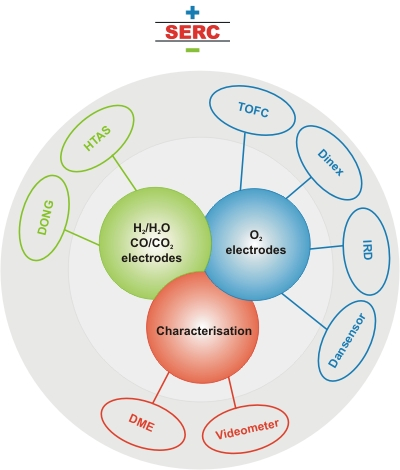The work of the Ph.D. students and postdocs takes places in close cooperation with the SERC industry partners. The synergy between the projects is inherent for SERC as all work is dealing with similar types of cells and establishment of new refined methods for studying these cells. The involved institutes contribute with significant efforts from staff financed by the institutes themselves. The relation between the many SERC partners is sketched below.

SERC is actively initiating external synergy relations between the projects and the industrial partners by ensuring close cooperation and exchange of knowledge. External synergy also includes work on related and relevant problems via the Risø DTU internal funding. Dedicated meetings ensure discussion of problems and communication of results.
Three companies are especially in focus concerning the synergy between SERC and the industry. These are Haldor Topsøe A/S, Topsoe Fuel Cell A/S and PBI-Dansensor A/S. According to SERC participants John Bøgild Hansen (HTAS) and Niels Christiansen (TOFC) the SERC activities such as development of advanced characterization method such as 3D image analysis results in a valuable tool for development of SOEC and SOFC. TOFC has a significant interest and commitment to follow and participate in the leading development in this field ensuring long term competitiveness. Ultimately they want to implement the results in future SOFC and SOEC components.
According to Rune Bech Abrahamsen, PBI-Dansensor A/S benefits from the knowledge obtained through SERC. This concerns both new electrode materials and the general design of the oxygen sensor. PBI-Dansensor will in the future test some of the electrode materials developed for SOFC on its zirconia oxygen sensors. The potential benefits are better performance, longer lifetime and also lower production cost. Despite PBI-Dansensor has been working with zirconia based sensors for more than 25 years some of the knowledge has been lost over the years. It has been of great value for them to have a close corporation with SERC because it has been a very effective and fast way to get a very high level of knowledge about the zirconia based sensor.
Videometer was inspired by the software development in project 5 “Automatic quantitative image analysis of 3D micrographs” and is now implementing the level set segmentation method developed in SERC project 5 into its basic software product VideometerLab. It is expected that the work will be continued during 2011 by Videometer.
DME and Risø DTU are working in close collaboration on the controlled atmosphere high temperature scanning probe microscopes in order to refine the second proto type microscope (CAHT-SPM-2) to both ensure the development of the microscope to a commercial level and to document its capabilities to perform advanced in situ analyses. CAHT-SPM-2 has now passed the site acceptance test and is ready for general testing. DME will continue to take part in the further testing and initial experiments by providing training and guidance. DME expects that this specialized instrument development will be the object for income later on.